 |
Please note : There are lots of large pictures on this page
these may take some time to download if using a dial up connection.
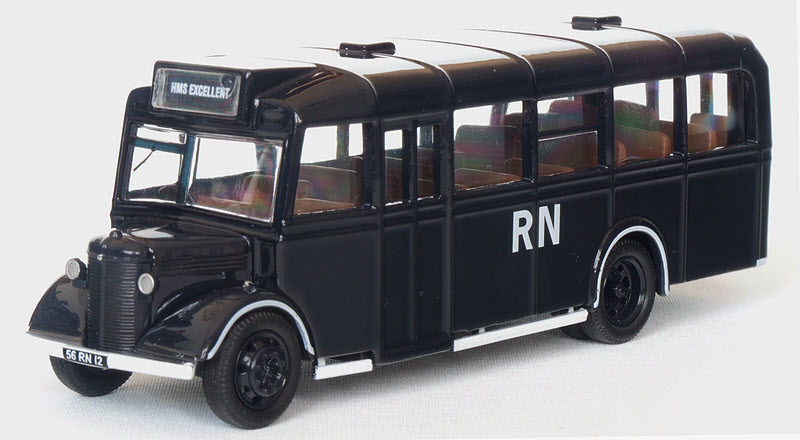
76OWB001 - Oxford Diecast's first Bedford OWB wears the dark blue livery used by the Royal Navy
|
A Brief History
The Bedford OWB Utility Bus
The OWB was a wartime version of Bedford OB, the OB itself was introduced to Bedford's range in 1939 but due to the out break of the second world war only a small number of vehicles were produced before Bedford switched its attention to producing military vehicles for the war effort.
In 1942 the Ministry of Supply sanctioned the production of utility buses to fill the growing need for new vehicles, these were used to both replace vehicles destroyed during the hostilities and others that had become unserviceable due to age.
Bedford was chosen to build the chassis for the single deck bus version and thus the OWB was born.
Strict specifications were put in place by the Ministry for both the chassis & bodywork. The body had a timber framed construction which used the minimum of materials and was designed so it could be constructed quickly. Curved panels were kept to the bare minimum resulting a simple but distinctive rear roof dome design.
In some instances poorly seasoned timber was used for the body framing with the result that in later life the bodies were often prone to premature rotting and/or warping problems.
Inside the vehicles the internal panelling was kept to the bare minimum and very basic wooden slatted passenger seats were fitted.
Between 1942 & 1945 over 3,300 OWBs were produced, several bodybuilders provided broadly identical bodies during this period but the majority were built by either Duple or Roe.
When the war ended in 1945 Bedford switched back to producing the OB, however due to austerity measures and the focus on exports the OB chassis was in short supply for many years prompting some operators to either upgrade their OWB vehicles with more luxurious seating, or rebody them with new Duple Vista coach bodies.
Most of the OWB buses had been withdrawn from service by the mid 1950's, today only a handful have survived into preservation with the original style utility body.
|
|
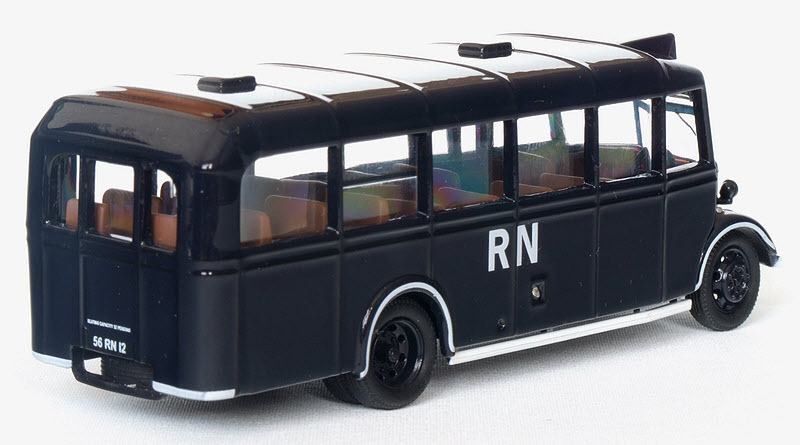
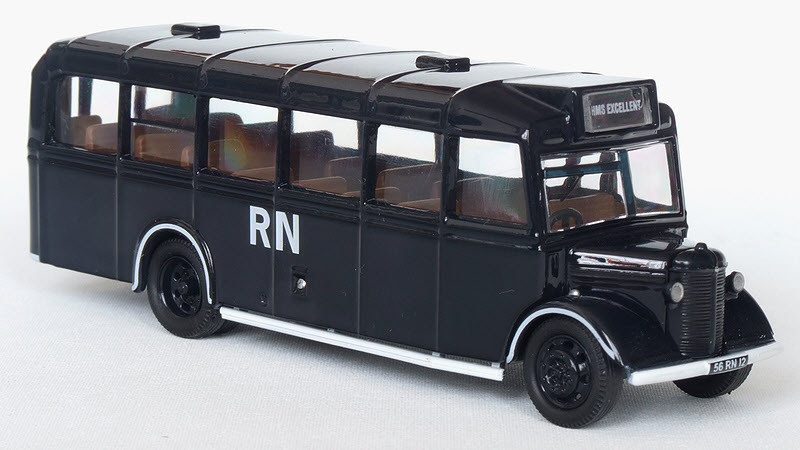
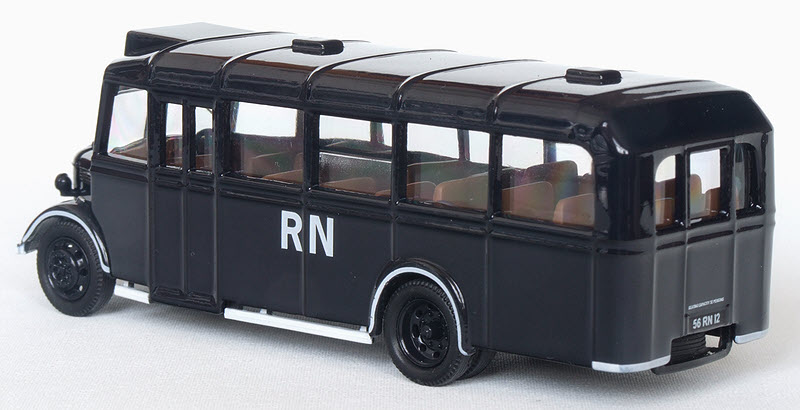
|
| The Model
The Bedford OWB is Oxford Die-cast's first proper foray into the 1:76 model bus market, it has been producing other 1:76 road vehicles including some toy like Routemaster models for a number of years but more recently the range has rapidly grown to include an impressive range of cars and commercials from various eras. The OWB itself has been produced initially for use in Oxford's new "Military" range however following the first two releases three bus operator versions have been announced which will all be released during 2012.
The first model reviewed here comes in the Royal Navy's dark blue livery, the bus in question was no doubt used to transport Navy personal during the war.
The model has a diecast body shell and front mudguards while plastic is used for the base and interior. Even with this high diecast content the model is very competitively priced with a SRP of £12.95. This is actually lower than the recently launched plastic bodied Duple Dominant coach from B-T Models and around half the price of the similarly sized EFE Bedford OB coach model.
|
|
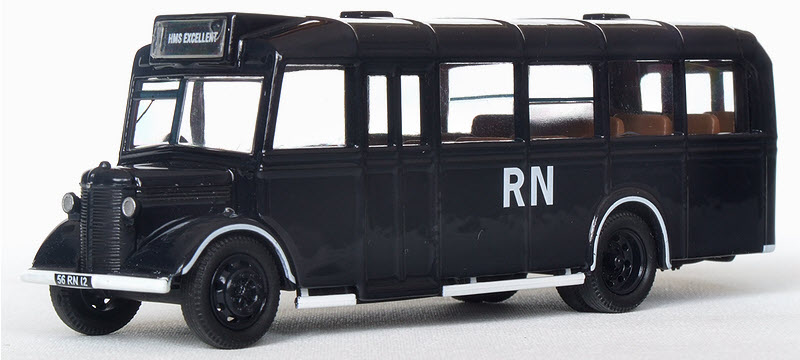
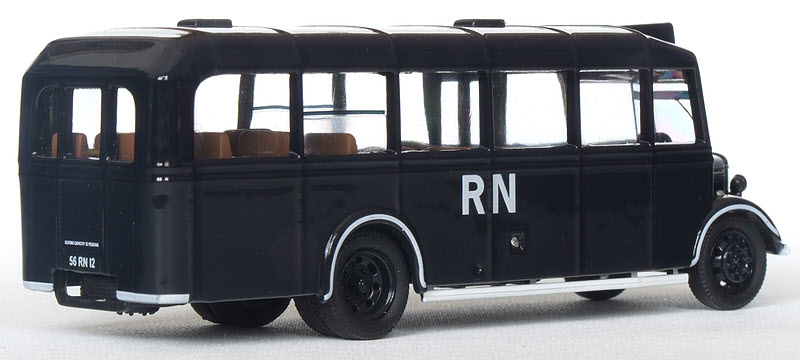

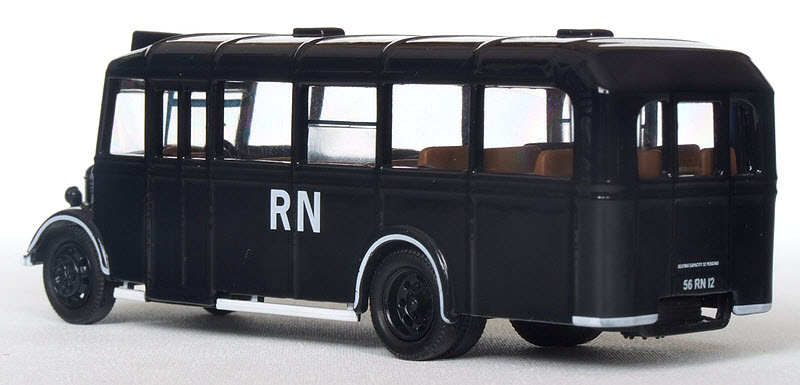
|
|
The main body has a good level of detail including full representation of the panel beading. Scale wise this is probably a little on heavy side but none the less gives the model its distinctive utilitarian appearance.
The model has a leaf type passenger door which is not surprisingly modelled in the closed position. There is representation of a door handle although I've been informed the real vehicles only had internal handles anyway.
The side window pillars are part of the body shell rather than being tampo painted onto the glazing, these are nice and thin and when viewed side on look perfectly acceptable for this type of vehicle.
The pillars are however much deeper than on the real vehicle but obviously this is a compromise necessary to make them robust enough to support the roof.
The off-side of the model has a fuel filler moulded into one of the panels and the cap for this has been picked out with silver paint. There is also recessed circle just below the filler which on the real bus would allow access to the petrol tank on/off tap.
|
|
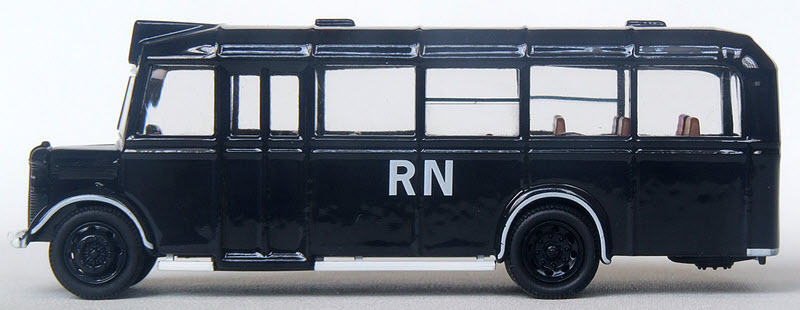
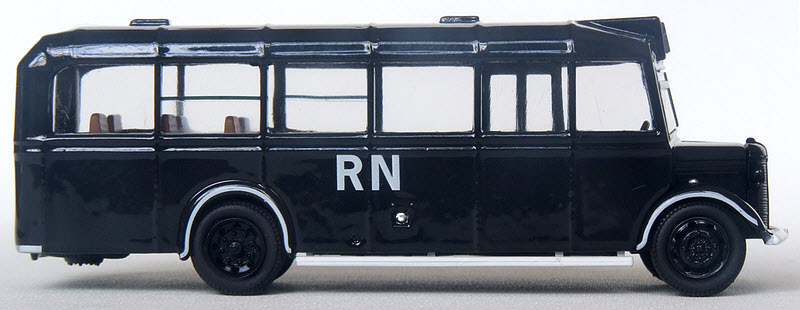
|
|
Moving on to the rear of the bus there is a centrally positioned emergency exit with two small windows either side, again there is no representation of any door handle. The characteristic angular utility style dome has been nicely reproduced.
A spare wheel has also been positioned centrally at the rear below the floor, only the tread of its rubber tyre is visible from the rear however.
One thing which is missing completely from the rear is any representation of the exterior driving lights, on the original vehicles there would have been a tiny stop lamp positioned on the outside edge of the cut out for the spare wheel.
|
|
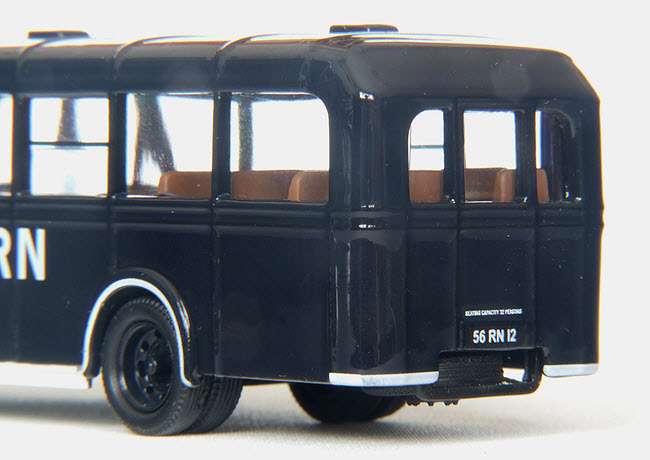
The spare wheel is held in place by the retaining bar at the rear and can easily be removed if desired
|
|
The engine housing is part of the main body casting and has detailing for the side vents and for the centrally hinged bonnet covers. The front mudguards are a separate diecast component and have small side lights cast on top of them which have been neatly highlighted with silver paint. The front bumper is also part of this casting component and on this particular model has been finished in white paint.
The radiator grille is another plastic part and is glued to the main body casting, the headlights are also a separate component which is fixed on a prong behind the radiator. Silver paint is once again used on the front of the lights & for the tiny radiator badge.
The windscreen is flush fitting and has the central support pillar and driver's horizontal window divider tampo printed directly on to it. The single windscreen wiper is reproduced using the same method.
The cast front pillars either side of the windscreen are again nicely proportioned resulting in a very pleasing overall front appearance.
|
|
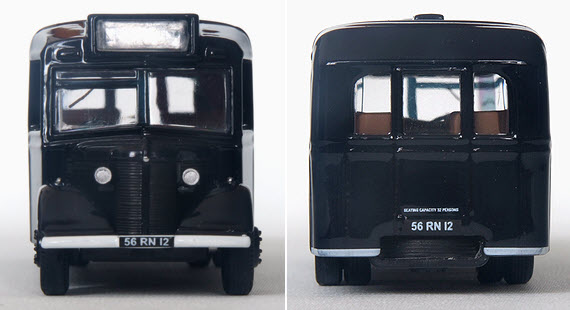
The model has a glazed destination display at the front and an emergency exit at the rear
|
|
The glazing overall is clear and fairly thin which eliminates any noticeable distortions, however I do feel on the sides & rear it could have been improved by making it more flush to the exterior panels, in its current form it rather highlights the deep window pillars and thickness of the body casting.
The model doesn't have any driving mirrors but in reality these were pretty inconspicuous on the real thing anyway.
The only destination display is that at the front, this has a clear plastic insert with the destination tampo printed behind it. The glazing is glued in place and has small lugs either end for this purpose, however the lugs are clearly visible through the plastic and thus slightly spoil the overall effect. Unfortunately on the randomly selected review model some of the glue had also been dropped on the back of glazing panel leaving a visible mark.
|
|
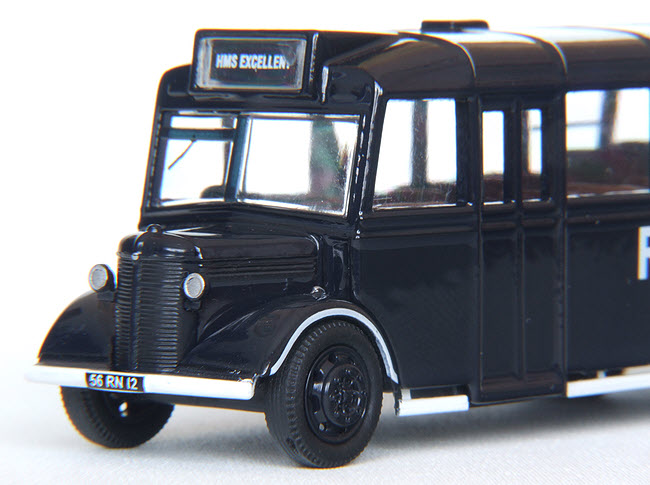
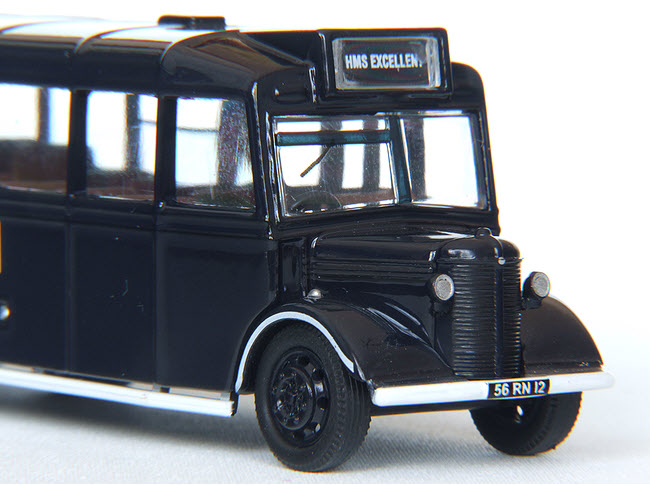
|
|
This particular model doesn't have a great deal of decals, but those that have been applied are crisp with even the tiny seating capacity on the rear being fully legible.
The model has white high visibility markings and all of these have been very neatly applied with the thin ones around the edges of the mudguards being of particular note.
|
|
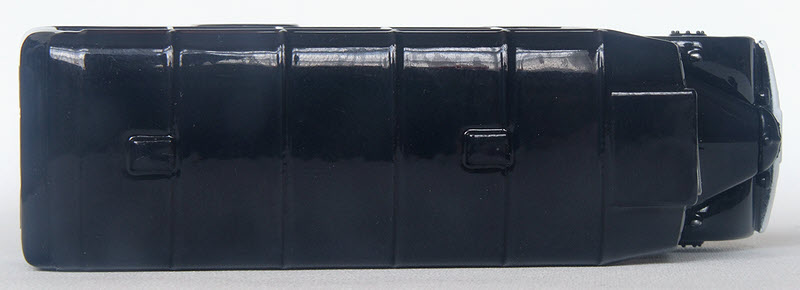
The roof has two air vents along the centre and raised beading for the individual roof panels and rear dome.
|
|
The plastic base plate is held in place by three cross head screws. A separate rear mounted spare wheel locates on a small lug and is held in place by pushing the edge of the type under the plastic cross bar at the rear. The spare can easily be removed if desired by lifting it off the central lug and pulling it forwards.
The wheel hubs are made of black plastic and have softer plastic tires. The hubs themselves are painted to match the body colour & are well detailed right down to having real holes through the outer edges, a feature I've not seen before on a 1:76 scale diecast bus.
|
|
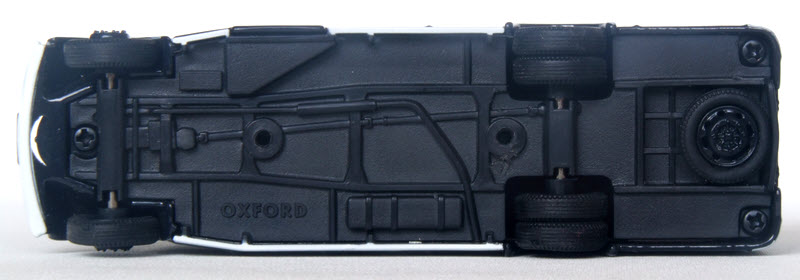
|
|
Returning to the baseplate this has a basic representation of the chassis framework, engine drive shaft, exhaust pipe and off-side fuel tank. The life guards along each side are also part of the base and have been painted white on this version.
The Royal Navy aren't renowned for running buses so bus collectors may find this particular release less appealing, the good news for those who like to do some repainting is that the model is extremely easy to dismantle.
Just remove the three cross head screws and the baseplate can be lifted off revealing the one piece interior plastic seating component and the glazing unit. Neither are secured to the main casting and can be removed with the minimum of effort.
The diecast front mudguards can also be removed with similar ease and although glued in place the radiator can be removed without causing any damage if due care is taken. The headlights can also be removed from the back of the radiator with some coaxing if desired.
Finally the glazed destination screen can be removed with the aid of a fingernail despite being glued in place.
|
|
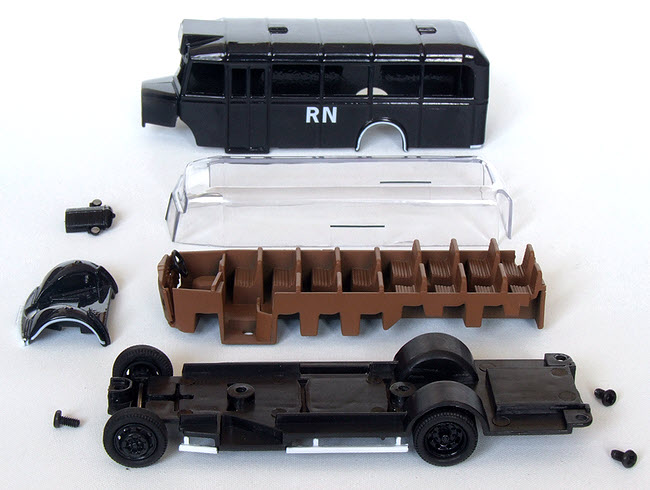
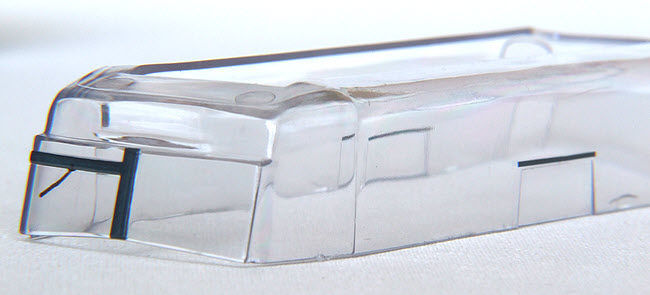
|
|
The interior detailing includes the stepped entrance and a full set of slatted wooden passenger seats. The basic dashboard is reproduced and includes two central dials and a separate black steering wheel, the interior does look a little bland due to its overall brown finish.
|
|
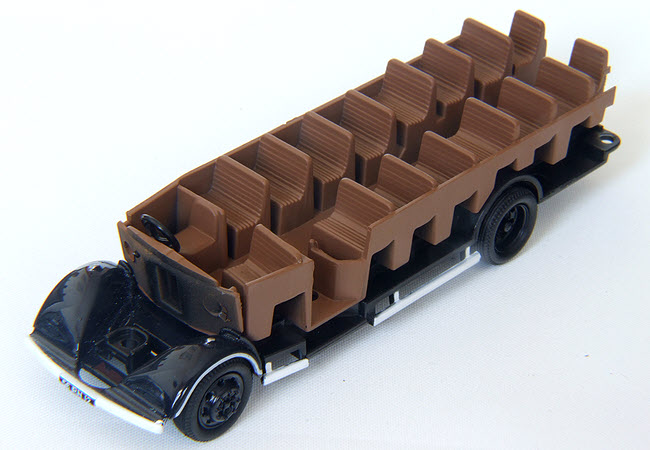
This version has slatted wooden utility seats but I understand Oxford
can also fit an alternative interior with more luxurious post-war upholstered seats.
|
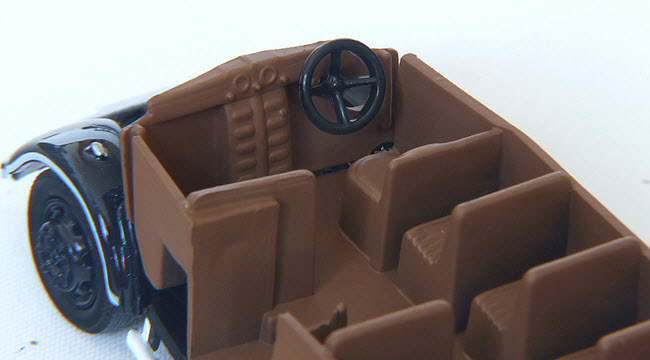
The drivers area has a simple dashboard and black steering wheel.
|
|
Overall for the asking price this model is really very good, granted it's not quite as refined when compared to some of the more recent offerings from some other well known manufacturers but it is still a very attractive and perfectly acceptable model which manages to capture the overall feel of these somewhat "rough & ready" vehicles very well.
|
|
|
My only other very minor criticism is that the rear tires rub the rear wheel arches slightly thus restricting their free movement.
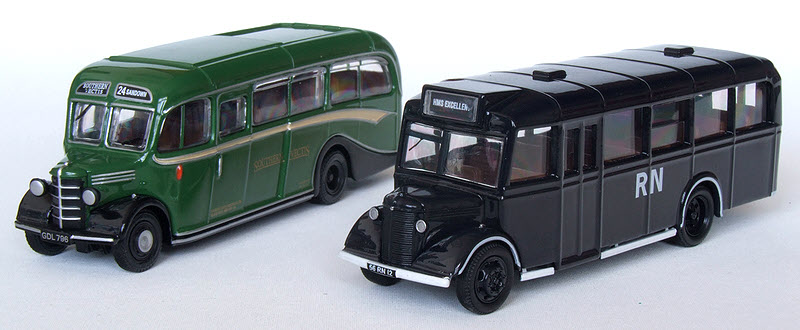
Side by side EFE's Bedford OB Coach & Oxford's Bedford OWB Bus
As can be seen above the Oxford model looks perfectly at home beside EFE's Bedford OB coach and with some proper bus operator versions already announced, and no doubt plenty of scope for many others, this model should prove very popular.
The model's construction and ease with which it can be dismantled should make it a good proposition for those wanting to do some modifications. The interior can also be easily enhanced with the aid of some paint and even a few passengers and crew if so desired.
We'll have to wait and see if this model marks the start of a range of other Oxford 1:76 bus and coach models. Oxford have already made a mark in N scale and an up scaled version of the Burlingham Sunsaloon or Plaxton Elite coach would certainly be welcome if they were up to the same standard as this OWB.
Thanks are extended to Peter Wilks, who is currently restoring an OWB, for pointing out some inaccuracies in my original draft of this review regarding missing exterior door handles on the passenger door, the purpose of the cut-out on the off-side & missing rear driving lights.
|
|
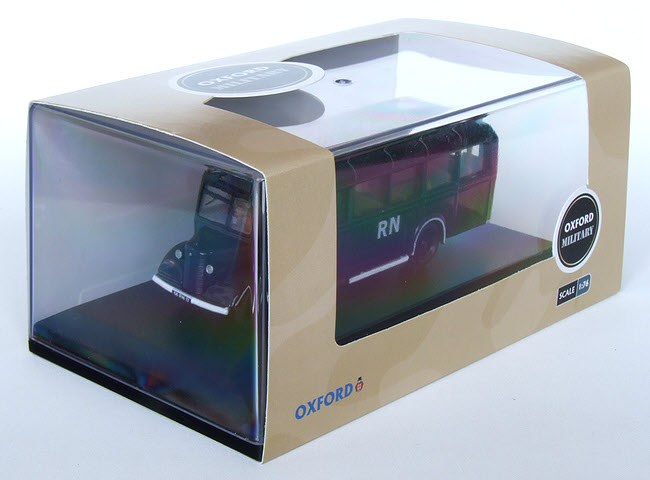
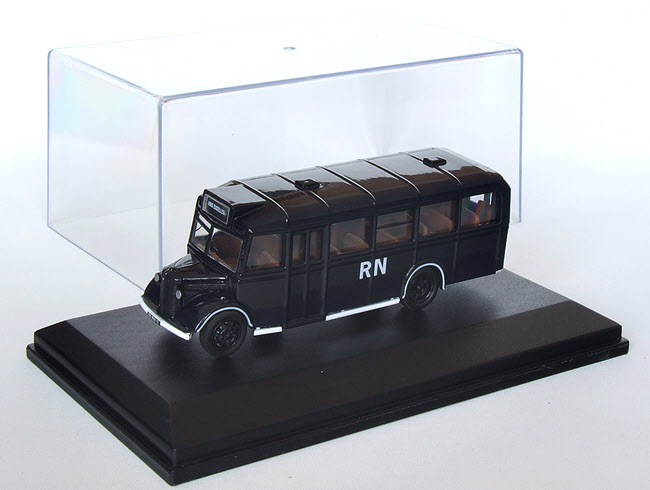
The model comes packaged in a plastic display case
|
|
Pros:
- Inexpensive
- Captures the essence of the vehicle
- Good body detailing
- Good clear glazing
- Easily dismantled for painting/modification
- Good paint finish and tampo printed decals
Cons:
- Front destination glazing looks a little poor
- Overly recessed glazing on sides & rear
- Drab single colour Interior
- Rear wheels rub arches
Marks:
Construction: 8/10
Livery Application : 10/10
Decal Application: 9/10
Interior Detailing 8/10
Likeness to Subject: 9/10
Overall: 8/10
|
|
| Model Review Index |























